How Much Is the New Ipad Pro Going to Cost
Should You Buy the iPad Pro?
The iPad Pro is Apple's high-end tablet computer. The latest iPad Pro models feature a powerful M1 chip, a Thunderbolt port, an improved front-facing camera, a Liquid Retina XDR mini-LED display option on the larger model, and up to 16GB of RAM and 2TB of storage. Apple typically updates the iPad Pro every 12 to 18 months.
There are two different iPad Pro models currently available. One has an 11-inch LED Liquid Retina display and a price starting at $799, while the other has a better 12.9-inch mini-LED Liquid Retina XDR display and a price starting at $1,099.

Announced in April of 2021, the M1 iPad Pros are around midway through their product cycle, meaning that now is still a good time to buy.
The 11-inch iPad Pro is the most portable iPad Pro option, also being thinner and lighter than its larger counterpart, whereas the 12.9-inch iPad Pro is the best option for entertainment and productivity tasks that can take advantage of the larger display.
Other than screen size, the two iPad Pro models have different display technologies. Although they both support the same key features like 120Hz ProMotion, P3 wide color, and True Tone, the 12.9-inch model has a mini-LED display. This allows the larger iPad Pro to deliver up to 1,000 nits of full-screen brightness, 1,600 nits of peak brightness, a 1 million-to-1 contrast ratio with deeper blacks, and true-to-life HDR. Users who consume or create HDR content, or would simply prefer a better display, should opt for the 12.9-inch model.
Beyond the screen size and display technology, the two iPad Pro models are identical. There is a $300 price difference between the smaller and larger model, so it is only worth getting the larger model if you can take advantage of the mini-LED display or the larger screen. It is also worth noting that some accessories, such as the Magic Keyboard and Smart Keyboard Folio, are $20 to $50 more expensive for the larger model.
The 2021 iPad Pro
Contents
- Should You Buy the iPad Pro?
- The 2021 iPad Pro
- How to Buy
- Reviews
- Issues
- Blooming
- RAM Limitations
- Design
- Display
- Mini-LED Liquid Retina XDR Display
- LED Liquid Retina Display
- Face ID and TrueDepth Camera System
- Selfie Camera
- M1 Chip
- Rear Cameras and LiDAR Scanner
- Battery Life
- Other iPad Pro Features
- Available Models
- Configuration Options
- Accessories
- Magic Keyboard and Trackpad Support
- Apple Pencil
- What's Next for the iPad Pro
- iPad Pro Timeline
Apple in April 2021 refreshed its iPad Pro lineup, introducing a faster M1 chip from the Mac, a Liquid Retina XDR display on the 12.9-inch model, 5G connectivity, a Thunderbolt port, and more.
When it comes to design, the iPad Pro is unchanged, available in 11 and 12.9-inch sizes with an all-screen design and an edge-to-edge display that does not include a Home button. Like the 2018 and 2020 iPad Pro models, the 2021 iPad Pro features a TrueDepth camera system with Face ID that uses facial recognition for biometric authentication, but it now features an upgraded 12-megapixel front-facing camera for selfies.
Both of the iPad Pro models feature an aluminum chassis in Silver or Space Gray with flat, rounded edges that wrap around the Liquid Retina display.
The 12.9-inch model features a new Liquid Retina XDR mini-LED display, bringing extreme dynamic range to the iPad Pro for the first time. The Liquid Retina XDR uses more than 10,000 LEDs across the entire back of the display and can deliver up to 1,000 nits of full-screen brightness, 1,600 nits of peak brightness, a 1 million-to-1 contrast ratio, and true-to-life HDR to enhance creative workflows for a "stunning" visual experience.
On the 11-inch model, the Liquid Retina display is unchanged from the 2020 model, featuring wide color support, True Tone for adjusting to ambient light, an anti-reflective coating, and ProMotion 120Hz refresh capabilities.
The rear camera system remains the same with two cameras, including a 12-megapixel wide-angle camera and a 10-megapixel ultra wide-angle camera that can zoom out two times for a wider field of view, as well as a LiDAR Scanner for AR experiences.
The 2021 iPad Pro's front-facing TrueDepth camera gains Center Stage to follow a user around a room during video calls, extended dynamic range for video up to 30 fps, and a brighter True Tone flash.
Inside, the 2021 iPad Pro is equipped with an M1 chip with the next-generation Neural Engine, featuring an 8-core CPU and an 8-core GPU. The M1 chip in the iPad Pro delivers up to 50 percent faster CPU performance than the previous A12Z Bionic. The 8-core GPU similarly delivers up to 40 percent faster GPU performance.
Through the M1 chip, the iPad Pro now comes with up to 16GB of RAM and up to 2TB of storage, just like Macs with the M1 chip.
The 2021 iPad Pro features a Thunderbolt port for the first time, allowing for much faster data transfer and support for Thunderbolt peripherals.
With the M1 chip, the 2021 iPad Pro models continue to feature an all-day battery life on a single charge. Other iPad Pro features include WiFi 6 support, Gigabit-class LTE for cellular models, and storage options ranging from 128GB to 2TB.
The 2021 iPad Pro works with the second-generation Apple Pencil that attaches to the iPad magnetically and charges from a direct physical connection, and the Magic Keyboard for iPad. Apple has also launched a new white color option for the Magic Keyboard alongside the 2021 iPad Pros, but be aware that the 2020 Magic Keyboard for the 12.9-inch iPad Pro does not fit the 2021 model perfectly.
Note: See an error in this roundup or want to offer feedback? Send us an email here.
How to Buy
The iPad Pro can be purchased from the online Apple Store and from third-party retailers like Best Buy and Amazon.
Pricing on the 11-inch iPad Pro starts at $799, while the 12.9-inch iPad Pro starts at $1099. Models with cellular connectivity are available for an additional $200 over the base price for each storage tier.
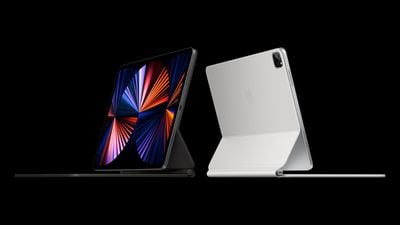
The Apple Pencil 2 that goes along with the iPad Pro is available for $129. The Smart Keyboard Folio for the 11-inch iPad Pro can be purchased for $179, while the Smart Keyboard Folio for the 12.9-inch iPad Pro can be purchased for $199.
The Magic Keyboard with trackpad is available for $299 for the 11-inch model, and $349 for the 12.9-inch version.
Reviews
Reviews of the iPad Pro with the M1 chip are positive, with reviewers praising the M1 chip, 5G connectivity, the iterative improvements to the front-facing camera, and the new Liquid Retina XDR mini-LED display. A thorough look at the improved performance and new display of the iPad Pro is shown in the review videos below.
The Liquid Retina XDR mini-LED display on the 12.9-inch iPad Pro was lauded as a "dream screen." The new display was said to be functionally equivalent to a high-end OLED TV and excellent for viewing HDR content with deep blacks.
5G connectivity was applauded as a "big deal" for users in areas with mmWave 5G coverage in particular, achieving faster speeds than gigabit Wi-Fi.
The 12MP front-facing camera's new Center Stage feature was also among the reviewers' favorites, keeping users perfectly framed during video calls. The feature worked surprisingly well, according to reviewers, panning around quickly and smoothly as needed.
While the new iPad Pro is around 50% faster than the previous generation model with the A12Z chip, most reviewers believed this impressive performance improvement was held back by the iPadOS operating system. Reviewers felt that even though the iPad Pro is "very, very capable, its software often feels hamstrung compared to the Mac."
This is similar to the opinion of the addition of a Thunderbolt port, where reviewers felt that the capability of the new port is held back by iPadOS, with limited support for peripherals like external monitors.
Reviews can help potential buyers make a decision about purchasing the new iPad Pro, and more information can be found in our dedicated review roundup.
Issues
Blooming
Some users have reported that the 12.9-inch iPad Pro's Liquid Retina XDR mini-LED display suffers from more blooming than expected.
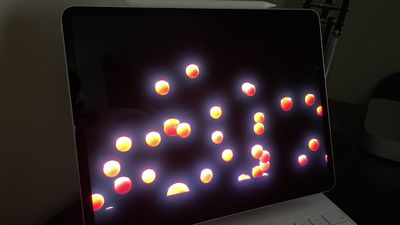
Thanks to the adoption of mini-LED display technology, the iPad Pro features 2,500 local dimming zones. Local dimming allows some areas of an LED screen to dim almost off for darker, truer blacks, while preserving the bright parts of the screen. The technology can increase the contrast ratio of images significantly and enable the intense highlights of HDR content.
On a display with local dimming, if a zone is lit up and an adjacent zone is not, there may be an artifact toward the part of the screen that becomes brighter than its neighboring zone called "blooming." OLED displays, such as those used on the iPhone 13 lineup, do not need local dimming since they are able to turn off individual pixels to achieve true blacks, all with no blooming effect. Local dimming can be a way to get near-OLED levels of picture quality, but it struggles to achieve the same level of contrast.
Blooming on the new 12.9-inch iPad Pro is therefore to be expected to some extent, but users seem to be divided about how bad the effect actually is. Blooming on the iPad Pro is believed to look much less severe in person than it does in images, likely due to exposure and image processing.
RAM Limitations
Despite Apple offering the M1 iPad Pro in configurations with 8GB and 16GB of RAM, developers indicated early on that apps were limited to just 5GB of RAM usage, regardless of the specs of the model the app was running on.
The M1 iPad Pro comes in two memory configurations; the 128GB, 256GB, and 512GB models feature 8GB of RAM, while the 1TB and 2TB variants offer 16GB of memory, the most ever in an iPad.
According to some developers, apps could only use 5GB of RAM on the iPad Pro and attempting to use anymore would cause the app to crash, meaning that developers were unable to tap the full potential of the available hardware. With the release of iPadOS 15 in September 2021, however, developers can now request entitlements from Apple to use up to 6GB of RAM on models with 8GB and up to 12GB on models with 16GB.
Aside from the single-app RAM limits, the added RAM, especially in the higher-end 1TB and 2TB models, can still benefit users by allowing them to keep more apps open in the background. iPadOS itself can access the M1's entire pool of unified memory, while apps can currently only access 6GB or 12GB of it.
Design
The 2021 iPad Pro models have received no major design refreshes and continue to look like the 2018 and 2020 iPad Pro models. The 11-inch iPad Pro measures in at 9.74 inches long and 7.02 inches wide, while the 12.9-inch model measures in at 11.04 inches long and 8.46 inches wide, meaning that it is over an inch wider and taller than the smaller model.
The 11-inch iPad Pro is 5.9mm thick, while the 12.9-inch model is 6.4mm thick. The 11-inch iPad Pro weighs in at 1.03 pounds and the 12.9-inch iPad Pro weighs 1.5 pounds. Apple offers the iPad Pro in either a Silver or Space Gray aluminum finish.
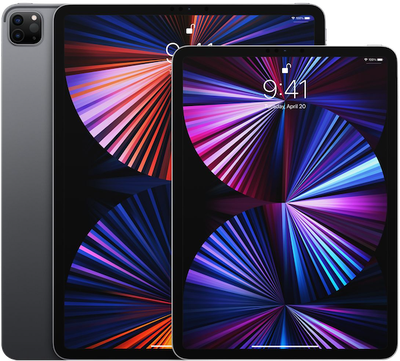
The 2021 iPad Pro models continue to feature an edge-to-edge display with 6mm bezels at the top, bottom, and sides. Rather than smooth, tapered edges, the iPad Pro models feature industrial flat sides like the iPhone 12 and iPhone 13. There is no Touch ID Home button, as the iPad Pro instead uses a TrueDepth camera system with facial recognition capabilities for Face ID biometric authentication. The TrueDepth camera is located in the top bezel of the iPad Pro.
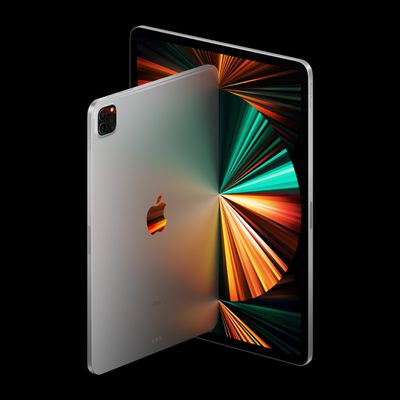
At the top of the iPad Pro, there's a sleep/wake button along with two speakers. On the right side, there are volume up and down buttons, a magnetic connector, and a nano-SIM tray on cellular iPads. As with previous models, there is no headphone jack on the iPad Pro and Bluetooth headphones or headphones that work with USB-C are required.
The square-shaped camera bump housing a wide-angle camera, ultra wide-angle camera, LiDAR Scanner, and True Tone flash remains unchanged from the 2020 model.
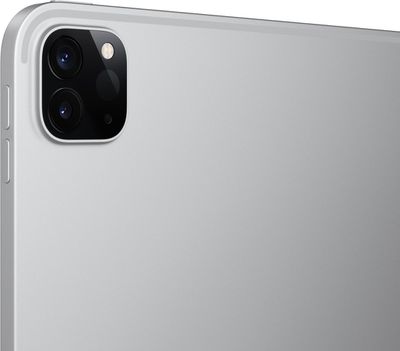
At the bottom of the iPad Pro there's a Thunderbolt/USB-C port for charging and connecting accessories. Thunderbolt allows the iPad Pro to connect to new Thunderbolt-only peripherals and transfer data at faster speeds, while still supporting standard USB-C accessories and cables like previous models.
Display
Mini-LED Liquid Retina XDR Display
The 12.9-inch iPad Pro features a brand new mini-LED display that Apple calls a "Liquid Retina XDR display" with a resolution of 2732 x 2048 at 264 pixels per inch. The Liquid Retina XDR display brings extreme dynamic range to the iPad Pro, offering a "stunning visual experience" with more true-to-life details and HDR.
Apple's mini-LED display on the iPad Pro uses over 10,000 LEDs across the entire back of the display, creating up to 1,000 nits of full-screen brightness, 1,600 nits of peak brightness, and a 1 million-to-1 contrast ratio. This captures the brightest highlights and subtle details in even the darkest images, allowing creatives to view and edit true-to-life HDR content on a large, portable display.
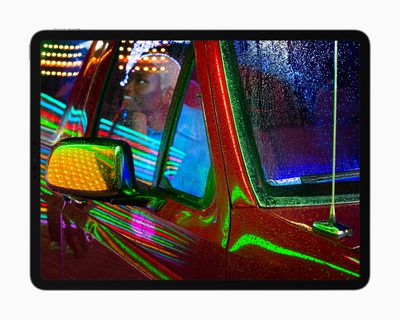
The Liquid Retina XDR display continues to feature display technologies from the previous iPad Pro, including 120Hz ProMotion, True Tone, and P3 wide color support.
LED Liquid Retina Display
The 11-inch iPad Pro continues to feature the same LED "Liquid Retina Display" as the 2020 model.

The 11-inch iPad Pro features a resolution of 2388 x 1668 at 264 pixels per inch. The display can deliver up to 600 nits brightness with just 1.8 percent reflectivity. It continues to have an antireflective and fingerprint-resistant coating.
Wide color support ensures rich, vivid colors that are true to life and accurate, while True Tone adjusts the display to match the white balance of the lighting in the room to make the screen easier on the eyes.
ProMotion display technology with a 120Hz display refresh rate is included, which makes content in motion on the screen smoother, crisper, and more responsive for scrolling, gaming, watching movies, and more.
The iPad Pro's display refresh rate is dynamic and can change depending on what is on screen as a battery-saving measure. When watching a movie or playing a game, the refresh rate is at 120Hz, but when reading a web page or looking at a photo, a 120Hz refresh rate is not needed, so it adjusts accordingly.
Face ID and TrueDepth Camera System
Instead of authenticating and unlocking through a Touch ID fingerprint system, the iPad Pro uses the Face ID feature that Apple has been adding to its products since 2017. Face ID does all of the same things that Touch ID does, like unlocking your iPad, allowing access to third-party passcode-protected apps, confirming purchases, and authenticating Apple Pay payments.
Face ID uses sensors and cameras built into the top bezel of the iPad Pro, and Apple calls its multi-component setup the TrueDepth camera. To create the scan of your face that is used for authentication purposes, a dot projector projects over 30,000 invisible infrared dots onto your face.
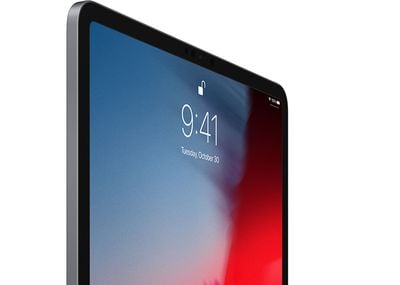
The dot map is read by an infrared camera and the structure of your face is relayed to the M1 chip in the iPad Pro where it is transformed into a mathematical model.
It takes just a fraction of a second for the iPad Pro to scan your face, recognize you, and unlock the device. Face ID is more secure than Touch ID, and it is unable to be fooled by a photo, mask, or other facial imitation. An "Attention Aware" security feature makes sure your iPad Pro only unlocks when you look at it with your eyes open, so it knows not to work when there is not a live person in front of it.
Face ID data is encrypted and stored in the Secure Enclave of the M1 chip. Authentication happens on-device, with no data stored in the cloud, sent to Apple, or accessible by apps.

Apple has designed Face ID to work in the dark, when wearing sunglasses, and with the face partially obscured by beards, glasses, makeup, scarves, and other accessories. Face ID is also able to adapt to changes in the face, so if you are slowly growing out a beard or your hair, it continues to recognize you.
Face ID on the iPad Pro works in both landscape and portrait orientation, a feature unique to the iPad. With iPhones, the device must be held in portrait orientation for Face ID to work properly.
Selfie Camera
The front-facing TrueDepth camera system includes a new 12-megapixel camera for selfies and FaceTime videos with a wider aperture, and it continues to support Portrait Mode, Portrait Lighting, and Animoji and Memoji.

A new Ultra Wide front camera enables Center Stage, a feature that automatically keeps users perfectly framed during video calls. Center Stage uses the much larger field of view on the new front camera and the machine learning capabilities of M1 to recognize and keep users centered in the frame.
As users move around, Center Stage automatically pans to keep them in the shot. When other people join in on the call, the camera detects them too, and smoothly zooms out to fit everyone into the view and make sure they are part of the conversation. Center Stage will work with FaceTime as well as third-party apps.
M1 Chip
The new iPad Pros are the first iPads to feature Apple's M1 chip, which was Apple's first custom silicon chip designed for the Mac. Apple says that the M1 chip gives the iPad Pro "a massive leap in performance."

The 8-core CPU design features the world's fastest CPU cores in low-power silicon, according to Apple, delivering up to 50 percent faster CPU performance than A12Z Bionic. Likewise, the 8-core GPU delivers up to 40 percent faster GPU performance. This has since been shown in early benchmarks.
The M1 chip in the iPad Pro also offers a number of custom technologies, including a next-generation 16-core Apple Neural Engine and a more advanced image signal processor (ISP).
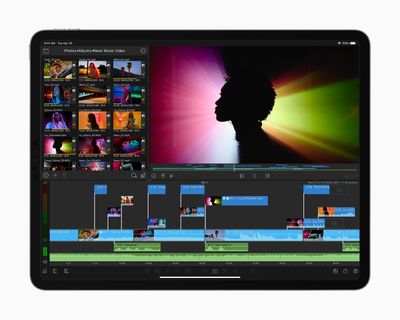
The M1 chip also allows the iPad Pro to support 2x faster storage and up to 2TB of storage for the first time, as well as a unified, high-bandwidth memory architecture with up to 16GB of memory for the first time. Previous models only supported up to 1TB of storage and 6GB of RAM.
Rear Cameras and LiDAR Scanner
The iPad Pro contains the same camera system as the previous model, featuring a 12-megapixel wide-angle camera with an ƒ/1.8 aperture and a 10-megapixel ultra wide-angle camera with an ƒ/2.4 aperture and a 125 degree field of view.
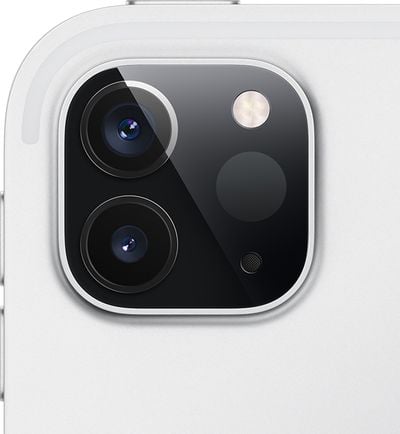
True Tone Flash, 5x digital zoom, 63-megapixel panoramas, wide color capture, noise reduction, smart HDR, burst mode, Live Photos support, and auto image stabilization are all included features. Like the 2018 and 2020 models, the 2021 iPad Pro models do not feature optical image stabilization.
Next to the two main cameras is a LiDAR Scanner (Light Detection and Ranging), which uses reflected light to measure the distance from the iPad Pro to surrounding objects that are up to five meters away (16.4 feet), either indoors or outdoors. The measurements are taken at the photon level at nano-second speeds.
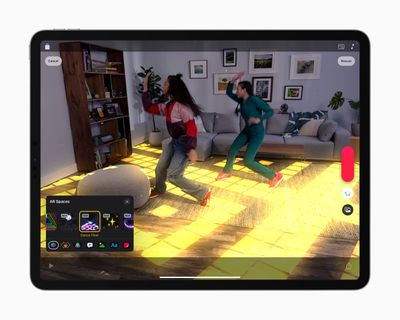
Depth frameworks included in iPadOS combine depth points measured by the LiDAR Scanner, data from the two cameras, and data from motion sensors with computer vision algorithms handled by the M1 chip to create a more detailed and complete understanding of a scene, allowing for instant AR placement, improved motion capture, and people occlusion.
The ISP and Neural Engine in the M1 make the iPad Pro's camera system more capable, bringing support for Smart HDR 3 for the first time. In low-light conditions, the ISP and LiDAR Scanner can quickly and accurately focus images and videos to capture details with almost no light at all.
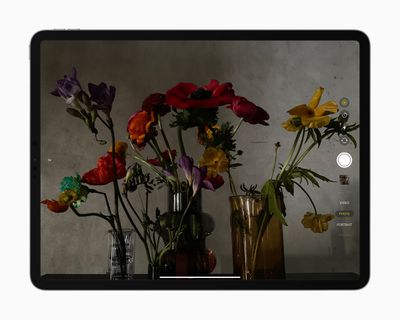
As for video, the iPad Pro can record 4K video at up to 60 frames per second with either camera, extended dynamic range for video up to 30 fps, slo-mo video, time-lapse video, and cinematic video stabilization when recording at 720p or 1080p.
Battery Life
Both iPad Pro models offer "all day battery life" with up to 10 hours of battery life when surfing the web or watching video, thanks to the power efficiency of the M1 chip. WiFi + Cellular models offer up to nine hours of battery life when surfing the web using cellular 5G.
Other iPad Pro Features
Microphones and Speakers
There are five studio-quality microphones included in the iPad Pro for capturing super clean audio and the quietest details.

Apple has also equipped the iPad Pro with a four-speaker audio setup that adjusts the sound to any orientation. There are two speakers at the top of the iPad and two speakers at the bottom, enabling stereo sound.
When an MFi compliant case such as the Magic Keyboard or Smart Keyboard is attached to the iPad Pro and closed, there's a hardware microphone disconnect feature that disables the microphone altogether.
5G Connectivity
Cellular iPad Pro models now offer 5G connectivity to deliver even faster wireless speeds when on the go.
Featuring the most 5G bands on any device of its kind, iPad Pro offers the broadest 5G coverage worldwide, according to Apple. iPad Pro models in the U.S. support millimeter wave, the higher frequency version of 5G, allowing iPad Pro to reach incredibly fast wireless speeds up to 4Gbps. In other countries, slower sub-6GHz 5G connectivity is available.
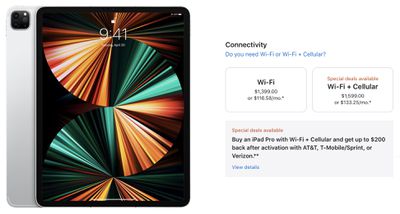
iPad Pro also offers support for eSIM, making it easy to find a network and sign up for a 5G data plan on the spot.
WiFi 6 and Bluetooth 5.0 Support
Like the previous model, the 2021 iPad Pro models support Bluetooth 5.0 and WiFi 6, otherwise known as 802.11ax. The updated standard offers faster speeds, improved network capacity, better power efficiency, lower latency, and upgraded connectivity when there are multiple WiFi devices in the same area.
WiFi 6 devices also support WPA3, which is a security protocol that offers improved cryptographic strength.
Storage and RAM
Apple's iPad Pro models start out with 128GB of storage and can be upgraded up to a maximum of 2TB.
RAM is also variable for the first time. iPad Pro models with 128GB, 256GB, or 512GB of storage come with 8GB of RAM, while iPad Pro models with 1TB or 2TB of storage feature 16GB of RAM.
Thunderbolt
The 2021 iPad Pro models have a Thunderbolt and USB 4 port for the first time, for 4x more bandwidth for wired connections than the previous iPad Pro, supporting speeds up to 40Gbps.
Thunderbolt supports 10Gbps Ethernet and opens up an ecosystem of high-performance accessories, like faster external storage and higher resolution external displays, including the Pro Display XDR at full 6K resolution. The iPad Pro can now support more peripherals and accessories than ever before and at much faster speeds.
Smart Connector
The Smart Connector on the back of the iPad Pro is designed to allow it to communicate with and power accessories like the Smart Keyboard Folio. The Smart Connector interface is able to transfer both power and data, so accessories that connect to the iPad Pro through it do not need batteries.
Available Models
There are two standard configuration of the iPad Pro available from Apple:
- $799 - 11-inch LED Liquid Retina display, Wi-Fi only, M1 chip, 8GB RAM, 128GB storage.
- $1,099 - 12.9-inch mini-LED Liquid Retina display, Wi-Fi only, M1 chip, 8GB RAM, 128GB storage.
Configuration Options
When purchasing the iPad Pro, it is possible to upgrade the storage and add 5G cellular connectivity:
- 256GB SSD - +$100
- 512GB SSD - +$300
- 1TB SSD - +$700
- 2TB SSD - +$1,100
- 5G Cellular - +$200
iPad Pro models with 128GB, 256GB, or 512GB of storage come with 8GB of RAM, while iPad Pro models with 1TB or 2TB of storage feature 16GB of RAM.
Accessories
Magic Keyboard and Trackpad Support
Apple offers the Magic Keyboard to accompany the iPad Pro, which is a folio-style case that features a full backlit keyboard and a trackpad. The Magic Keyboard uses scissor mechanisms much like the keyboard of the MacBook Air and the MacBook Pro to provide 1mm of travel.
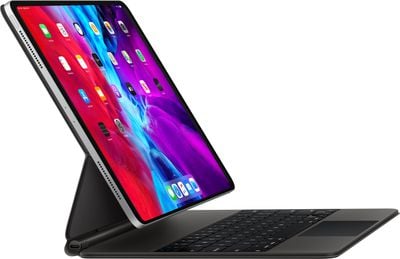
The Magic Keyboard attaches to the iPad Pro through a magnetic connection, and it features cantilevered hinges that allow it to work on a desk or on a lap. The hinges allow for adjustments of the viewing angle up to 130 degrees, so it can be tweaked for every usage situation.

The design of the Magic Keyboard allows the iPad to "float" in the air, with the bottom part of the case tilting backwards when used in keyboard mode.
When not in use, the keyboard's folio-style design keeps the iPad Pro safe, covering the front and back of the iPad. A USB-C port is included on the Magic Keyboard for passthrough inductive USB-C charging capabilities, leaving the iPad Pro's Thunderbolt port free for accessories like external drives and displays.
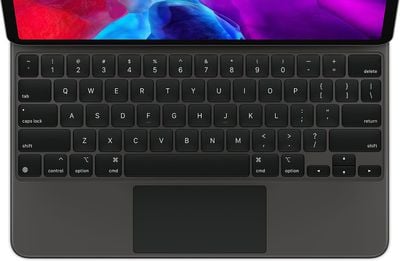
Gestures on the trackpad are designed to let users switch between apps, access the app switcher, and activate the Dock, Control Center, and apps in Slide Over. Multi-touch gestures on the trackpad allow for quick and easy navigation through iPadOS.
Apple designed trackpad support to integrate into both first and third-party apps. Scrolling through web pages in Safari and photo libraries in Photos is supported, for example, as is precisely editing text in notes and other apps, viewing and organizing email in Mail, and more.
With the 2021 iPad Pros, the Magic Keyboard now comes in a new white color option.
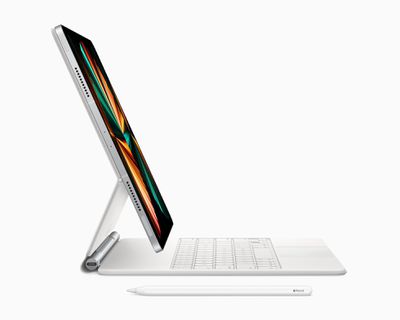
While the iPad Pro was designed to work with the Magic Keyboard for iPad, it also supports the Magic Mouse, Magic Mouse 2, Magic Trackpad, Magic Trackpad 2, and third-party mice options using Bluetooth or USB.
Apple also offers the standard Smart Keyboard Folio for the 2021 iPad Pro models as a lower-cost alternative to the Magic Keyboard, without backlighting, trackpad, or scissor-mechanism.
Apple Pencil
2021 iPad Pro models work with the second-generation Apple Pencil that was introduced in 2018. Priced at $129, the Apple Pencil connects to the iPad Pro using magnets, and when attached magnetically, it charges inductively. Pairing is also achieved through the magnetic attachment.
![]()
Gesture support is included with the second-generation Apple Pencil, and with a tap, you can change brushes or quickly switch from a brush to an eraser without having to pick up the pencil and select a new tool.
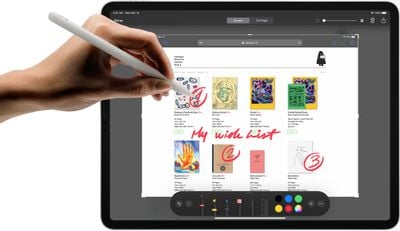
The Apple Pencil works across the iPad Pro, with first and third-party apps, though it is designed primarily for use in writing and sketching apps. It features advanced palm rejection, extreme precision, and imperceptible lag for a paper-like writing experience that's unmatched by third-party styluses.
Pressure support allows thinner and thicker lines to be drawn by increasing the amount of pressure on the iPad's screen, and side nib detection allows for shading when the Apple Pencil is tilted.
What's Next for the iPad Pro
Wireless Charging
A new version of the iPad Pro rumored to debut in 2022 is expected to feature a glass back instead of an aluminum back, a feature that will allegedly enable wireless charging. Apple is rumored to be planning to add MagSafe charging capabilities to the 2022 iPad Pro, similar to the iPhone 12 and iPhone 13 models.
Apple is also allegedly working on reverse wireless charging for the new iPad Pro, which would allow users to charge their iPhones, AirPods, and other accessories by laying them on the back of the iPad. Both the 11 and 12.9-inch 2022 iPad Pro models are expected to feature a mini-LED display, an improvement over the 2021 iPad lineup where mini-LED is limited to the 12.9-inch model.
3nm A-Series Chip
Starting in 2022, Apple's iPads are expected to feature a next-generation A-series chip built on TSMC's improved 3-nanometer process. The news comes from Nikkei Asia, and while the report doesn't specify which iPad might be first to get the new chip, it's likely to be the iPad Pro.
3nm technology can increase processing performance by 10 to 15 percent compared to 5nm technology, while also reducing power consumption by 25 to 30 percent.
A New Apple Pencil?
Images purportedly of a next-generation Apple Pencil surfaced in March 2021, followed by a brief video in April, with a design that is similar to the current Apple Pencil but with a glossy finish. The leaked pencil also appears to have a larger tip component, but its purpose is unknown. The leaker who shared the photos also previously said that a black Apple Pencil color option is in the works, but rumors also suggested the new Apple Pencil would debut alongside the 2021 iPad Pro models, which did not happen.
Face ID Updates
Future iPhones and iPads will be equipped with smaller VCSEL Face ID scanner chips, which will help Apple cut production costs and will also result in smaller notch designs. These smaller components enabled the slimmed-down notch in the iPhone 13, and may also bring iPad changes in the future.
Titanium Chassis
Future versions of the iPad could use a titanium alloy chassis design, which would replace the aluminum used in current models. Titanium would be more resistant to scratches and bending due to its hardness.
DigiTimes says that Apple is working on this technology, though it's not known if and when a titanium chassis would be made available. Because this process is expensive, it could initially be limited to higher-end iPad models.
Orientation Changes
Leaker Dylandkt claims that a future iPad Pro could feature a horizontal camera alignment and a landscape-oriented Apple logo on the back, a change that Apple is supposedly implementing to promote usage of the iPad in landscape mode rather than portrait mode.
OLED Rumors
Apple could add an OLED display to the iPad Pro lineup in 2023 or 2024, according to Korean website The Elec. Right now, Apple uses mini-LED technology for the iPad Pro, but could transition to OLED technology that would support a wider range of refresh rates.
For future-generation versions of the iPad Pro, Apple is working on OLED displays and is in discussions with Samsung and LG for OLED panels with a two-stack tandem structure. This setup would allow for displays that are much brighter with up to double the luminance.
Apple was originally working on an OLED iPad for 2022, with that model positioned as an iPad Air, but Apple abandoned the project and is no longer planning an OLED iPad for 2022. If Apple does adopt OLED for the iPad Pro, there are a number of benefits like increased brightness, deeper blacks, better contrast, faster response times, and sharper colors, as well as thinner devices since OLED panels are slimmer than LCDs.
Other iPad Pro Rumors
Other rumors have suggested that Apple is working on an OLED iPad set to launch in early 2022. The first iPad expected to adopt an OLED display is said to be a 10.9-inch model, presumed to be an updated version of the iPad Air, but Apple is also reportedly considering using OLED for the 12.9-inch iPad Pro.
Apple has previously been rumored to be in talks with Samsung over OLED displays for future iPad Pro models. Barclays analysts also believe that an OLED iPad will launch no earlier than 2022.
OLED displays could bring benefits like increased brightness, deeper blacks, better contrast, faster response times, and sharper colors, as well as thinner devices since OLED panels are slimmer than LCDs.
A sketchy rumor suggested Apple was working on an iPad with a foldable display to be launched in 2020, which was presumed be an iPad Pro, but that obviously did not come to fruition.

Jeff Lin, the IHS Markit analyst who made the claim, said that the foldable iPad will feature a display in the 12-inch range with 5G connectivity. UBS also predicted in 2019 that Apple would introduce a foldable iPhone or a foldable iPad by 2021, though this is just speculation and with 2021 coming to a close, there are no signs of an imminent launch.
Larger iPads
According to Bloomberg's Mark Gurman, Apple is working on future iPads with larger displays, but larger iPads are not expected to be released for a couple of years. The current largest iPad has a 12.9-inch screen, so future iPads could be even larger.
11-inch iPad Pro (2021): Cellular, 1 TB - Silver
N/A
$1699.00
11-inch iPad Pro (2021): Cellular, 1 TB - Space Gray
N/A
$1699.00
11-inch iPad Pro (2021): Cellular, 128 GB - Silver
N/A
$999.00
11-inch iPad Pro (2021): Cellular, 128 GB - Space Gray
N/A
$999.00
11-inch iPad Pro (2021): Cellular, 2 TB - Silver
N/A
N/A
$2099.00
11-inch iPad Pro (2021): Cellular, 2 TB - Space Gray
N/A
$2099.00
11-inch iPad Pro (2021): Cellular, 256 GB - Silver
N/A
$1099.00
11-inch iPad Pro (2021): Cellular, 256 GB - Space Gray
N/A
$1099.00
11-inch iPad Pro (2021): Cellular, 512 GB - Silver
N/A
$1299.00
11-inch iPad Pro (2021): Cellular, 512 GB - Space Gray
N/A
$1299.00
11-inch iPad Pro (2021): Wi-Fi, 1 TB - Silver
N/A
$1499.00
11-inch iPad Pro (2021): Wi-Fi, 1 TB - Space Gray
N/A
$1499.00
11-inch iPad Pro (2021): Wi-Fi, 128 GB - Silver
N/A
$799.00
11-inch iPad Pro (2021): Wi-Fi, 128 GB - Space Gray
N/A
$799.00
11-inch iPad Pro (2021): Wi-Fi, 2 TB - Silver
N/A
$1899.00
11-inch iPad Pro (2021): Wi-Fi, 2 TB - Space Gray
N/A
$1899.00
11-inch iPad Pro (2021): Wi-Fi, 256 GB - Silver
N/A
$899.00
11-inch iPad Pro (2021): Wi-Fi, 256 GB - Space Gray
N/A
$899.00
11-inch iPad Pro (2021): Wi-Fi, 512 GB - Silver
N/A
$1099.00
11-inch iPad Pro (2021): Wi-Fi, 512 GB - Space Gray
N/A
$1099.00
11-inch iPad Pro Magic Keyboard (2020) - Black
$299.00
11-inch iPad Pro Magic Keyboard (2021) - White
N/A
$299.00
11-inch iPad Pro Smart Keyboard Folio (2020)
N/A
$179.00
12.9-inch iPad Pro (2021): Cellular, 1 TB - Silver
N/A
$1999.00
12.9-inch iPad Pro (2021): Cellular, 1 TB - Space Gray
N/A
$1999.00
12.9-inch iPad Pro (2021): Cellular, 128 GB - Silver
N/A
$1299.00
12.9-inch iPad Pro (2021): Cellular, 128 GB - Space Gray
N/A
$1299.00
12.9-inch iPad Pro (2021): Cellular, 2 TB - Silver
N/A
$2399.00
12.9-inch iPad Pro (2021): Cellular, 2 TB - Space Gray
N/A
$2399.00
12.9-inch iPad Pro (2021): Cellular, 256 GB - Silver
N/A
$1399.00
12.9-inch iPad Pro (2021): Cellular, 256 GB - Space Gray
N/A
$1399.00
12.9-inch iPad Pro (2021): Cellular, 512 GB - Silver
N/A
$1599.00
12.9-inch iPad Pro (2021): Cellular, 512 GB - Space Gray
N/A
$1599.00
12.9-inch iPad Pro (2021): Wi-Fi, 1 TB - Silver
N/A
$1799.00
12.9-inch iPad Pro (2021): Wi-Fi, 1 TB - Space Gray
N/A
$1799.00
12.9-inch iPad Pro (2021): Wi-Fi, 128 GB - Silver
N/A
$1099.00
12.9-inch iPad Pro (2021): Wi-Fi, 128 GB - Space Gray
N/A
$1099.00
12.9-inch iPad Pro (2021): Wi-Fi, 2 TB - Silver
N/A
$2199.00
12.9-inch iPad Pro (2021): Wi-Fi, 2 TB - Space Gray
N/A
$2199.00
12.9-inch iPad Pro (2021): Wi-Fi, 256 GB - Silver
N/A
$1199.00
12.9-inch iPad Pro (2021): Wi-Fi, 256 GB - Space Gray
N/A
$1199.00
12.9-inch iPad Pro (2021): Wi-Fi, 512 GB - Silver
N/A
$1399.00
12.9-inch iPad Pro (2021): Wi-Fi, 512 GB - Space Gray
N/A
$1399.00
12.9-inch iPad Pro Magic Keyboard (2020)
N/A
$349.00
12.9-inch iPad Pro Magic Keyboard (2021) - Black
N/A
$349.00
12.9-inch iPad Pro Magic Keyboard (2021) - White
N/A
$349.00
12.9-inch iPad Pro Smart Keyboard Folio (2020)
N/A
N/A
$199.00
How Much Is the New Ipad Pro Going to Cost
Source: https://www.macrumors.com/roundup/ipad-pro/#:~:text=Pricing%20on%20the%2011%2Dinch,Pro%20is%20available%20for%20%24129.